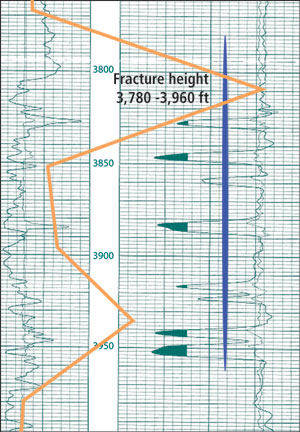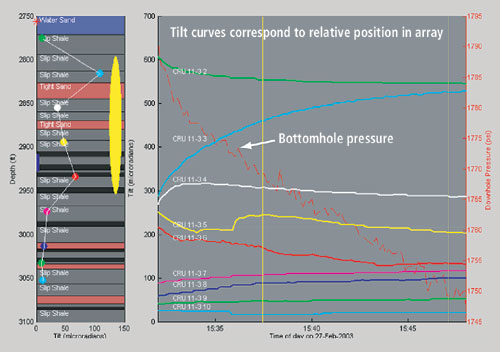|
| |
|

By Petroleum Technology Transfer Council |
Fracture mapping and modeling optimize CBM fracture treatments
Use of in-well tiltmeters and fracture modeling enabled the operator to achieve significant, per-well cost savings at two CBM fields in the western US.
Lloyd Stutz, Anadarko Petroleum Corp., and Kevin Fisher, Pinnacle Technologies, Houston
Anadarko Petroleum Corp. employed advanced fracture mapping technology by using new, in-well tiltmeters and fracture modeling to optimize hydraulic fracture stimulation treatments in two coalbed methane (CBM) plays. The plays are in Utah's Helper field and the Copper Ridge field of southwestern Wyoming.
At Helper, data from tiltmeters proved that single-stage treatments could stimulate the entire multi-seam interval. Savings of $35,000 to $50,000/well were realized, compared to prior multiple-stage treatments. At Copper Ridge, treatments were optimized to stay away from permeable water sands. Savings from reduced water production were $1.3 million in the first year. In addition, individual well treatment costs are lower, ranging from $100,000 to $150,000 less per well. Anadarko's cost savings in stimulations and disposal for the 16-well, Copper Ridge pilot program exceeded the actual costs incurred for fracture treatments.
TILTMETERS FOR MAPPING FRACTURES
Several diagnostic technologies are commercially available to map hydraulic fracture growth. Surface tiltmeters measure fracture orientation, but there can be surface access issues. Tiltmeters or microseismic arrays can be used in offset wells, but those wells are often not available.
Fortunately, tiltmeter technology has been adapted, so that tools can be deployed in the well being treated. An array of downhole tiltmeter instruments is run into the wellbore prior to beginning the treatment. The tools are coupled to the wellbore with magnetic decentralizers. Pumping begins, and induced tilt is measured at each tool, allowing fracture height to be measured in real time. These real-time data are particularly critical for the complex fracturing often seen in CBM development. Fracture geometry is directly measured as a function of actual treatment parameters. The result is a calibrated fracture model that enables quick optimization of treatment designs.
HELPER FIELD
At Helper field, the targeted Ferron coal seams are interspersed with tight gas sands over a 250-ft interval. Early in its history, the standard industry practice for completing CBM wells at Helper had been multiple-stage treatments, to ensure that the entire interval was stimulated. Anadarko employed fracture mapping from Treatment Well Tiltmeter (TWT) data and fracture modeling, to evaluate and optimize perforation and hydraulic fracture stimulation treatments. The obvious driver was to obtain equivalent or better performance at lower cost by treating the interval with a single frac stage.
Anadarko employed TWTs on several wells, where proppant-free, crosslinked gel fracs were pumped through perforations in the interval's center. Data clearly show that the fracture on this well grew 180 ft (to 3,960 ft from 3,780 ft), to cover the majority of the pay interval from this single stage, Fig. 1. The log shows five to seven coal seams that would have required several stages to stimulate, using earlier frac design strategies. This well was perforated only in the middle seam (at 3,880 to 3,890 ft) and was fracture-stimulated in a single stage. The orange curve shows tilt magnitudes from the TWT array on this frac, demonstrating conclusively that the fracture height effectively covered all coal seams. The fracture top was measured at 3,780 ft, and the bottom at 3,960 ft.
 |
Fig. 1. This compensated density log is from a CBM well in Helper, Utah.
|
|
Subsequent, other treatments successfully stimulated the entire interval in one stage. Production results are as good, or are slightly better, than neighboring wells fractured in multiple stages. Cost savings average $35,000 to $50,000/well.
COPPER RIDGE FIELD
Anadarko's CBM production at Copper Ridge field comes from the Almond coals. The Almond coals are present in 2- to 12-ft stringers spread over a 100-to 300-ft gross interval at depths ranging from 2,600 to 3,000 ft. The most prolific seams are usually perforated and fracture-treated in one or two stages using crosslinked gel with a combination of 16/30 and 20/40 sand.
The Ericsson sand, used for water disposal, underlies the coal sections, while higher-permeability water sands overlay the sections. An early pilot program to optimize hydraulic fracture stimulation treatments had several goals, including learning how to:
- Stay out of water zones
- Minimize the number of stages while still achieving complete interval stimulation
- Create long fractures with adequate conductivity.
Fracture mapping occurred on six wells, and fracture engineering and modeling were performed. Where fractures were mapped, growth was measured in real time. The measured fracture growth was then incorporated into the software program, FracproPT, along with pressures, volumes and injection rates. This allowed on-site adjustments to prevent fracturing into the adjacent water sands. The fracturing model was quickly optimized and used on all subsequent wells.
In a technology first, tiltmeter data were gathered while proppant was pumped. Previously, data had only been gathered during proppant-free stages, such as with mini-fracs, acid fracs and water-only fracs. To ensure that it could be done, the tools were first tested in Halliburton's flow loop. This process determined the safe operating envelope of pumping rate, viscosity, sand concentration and job duration, within which the tools and wireline could safely operate.
Data from one well reveal how the fracture top and bottom can be seen easily, Fig. 2. The right-hand plot indicates tilt magnitude at each tool vs. time. The left-hand plot shows the movement measured at each tool during a specific time window. Large amounts of tilt at left indicate the presence of a fracture.
 |
Fig. 2. In this real-time tiltmeter display from a frac in Copper Ridge, Wyoming, the right panel shows tilt magnitude vs. time for each tool during fracturing. Far-left panel is a snapshot of tilt magnitude vs. depth. Fracture height can be easily seen in real time, extending from 2,800 ft down to 2,950 ft during this portion of the treatment.
|
|
This treatment did show some propensity for upward growth toward the overlying water sands. The proppant ramp was adjusted, accordingly, to be more aggressive early in the treatment. This ensured adequate conductivity if the treatment needed to be halted early, due to the fracture top getting too near the water sands. The propped treatment was pumped to completion while monitoring fracture height in real time. Treatment avoided growth into the overlying water sand, visible at around 2,775 ft.
Once the model was successfully calibrated, it was used to develop correlations between frac treatment size, rate vs. height, and length growth. Initial treatment designs had called for 150,000 to 350,000 lbs of proppant at rates of about 40 bpm. Tilt measurements showed that undesirable height growth was occurring with the larger volumes and at higher rates.
Thus, the calibrated model was built, and it confirmed (with additional mapping) that treatments would remain fairly well contained at around 75,000 lbs of proppant and 25 bpm. Treatment volumes changed substantially from the original designs and were further modified on-the-fly, based on direct measurements incorporated into the calibrated fracture model. Modified proppant volumes varied from 32,000 to 154,000 lbs, and only one early screen out was encountered. After that, treatments were altered to use smaller proppants (20/40) and a less aggressive proppant ramp early in the schedule, but still finishing with 16/30.
Early use of these fracture diagnostics produced a calibrated model that enabled subsequent fracture treatments to be optimized quickly. Anadarko estimates savings of about $1.3 million in the first year, alone, from reduced water production. This is because water production was about 1/3 of the amount expected if treatments had broached adjacent water sands. With smaller volumes, treatment costs were measurably lower – from $100,000 to $150,000 less per treatment. Treatment costs were more than covered by savings found in the initial pilot wells. Anadarko continues to realize ongoing cost savings. 
ACKNOWLEDGMENT
A substantial portion of the case study in this article is based on information presented in two SPE papers: (1) SPE 84490, “Optimizing fracture stimulation in a new coalbed methane reservoir in Wyoming using treatment well tiltmeters and integrated fracture modeling,” 2003 Annual Technical Conference, Denver, Colorado; and (2) SPE 77443, “Calibrating coalbed methane fracture geometry in the Helper field using treatment well tiltmeters,” 2002 Annual Technical Conference, San Antonio, Texas.
THE AUTHORS
|
| |
H. Lloyd Stutz is engineering supervisor for Anadarko's Rockies Operations Group, as well as project leader for two separate CBM assets. He has extensive experience with CBM operations, tight gas sand completions, and HP/HT sour gas wells. Mr. Stutz has written several technical papers on sand control, perforating and hydraulic fracturing diagnostics. He earned a BS degree in petroleum engineering from Texas A&M University in 1988. He may be contacted at Lloyd_Stutz@anadarko.com.
|
| |
Kevin Fisher is VP of business development for Pinnacle Technologies in Houston. He has written more than two dozen articles and technical papers on hydraulic fracturing diagnostic tools, and he holds five US patents. Prior to Pinnacle, Mr. Fisher worked for Halliburton Energy Services and ProTechnics. He holds a BS degree in physics from Cameron University. He can be contacted at Kevin.Fisher@pinntech.com.
|
| |
|
|




